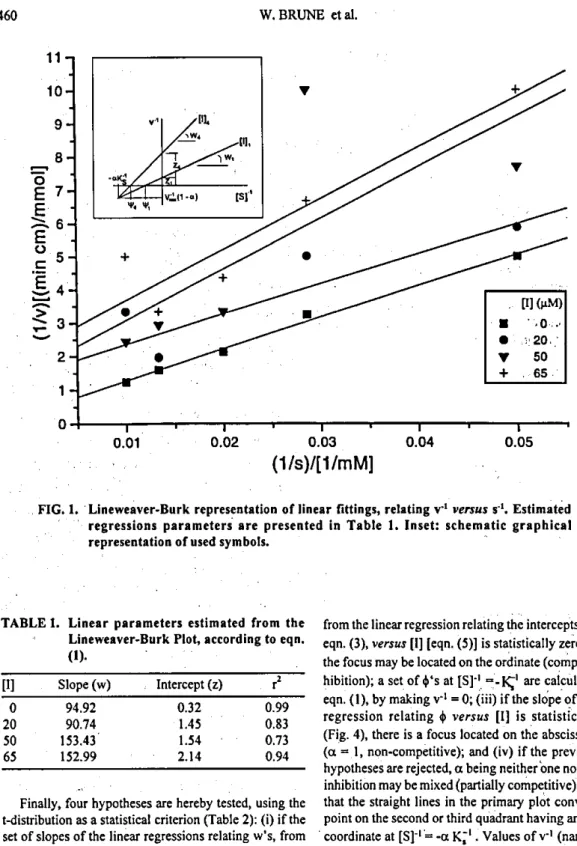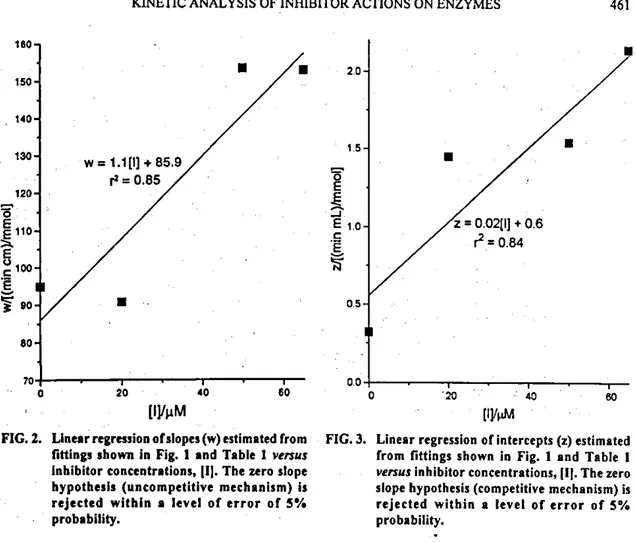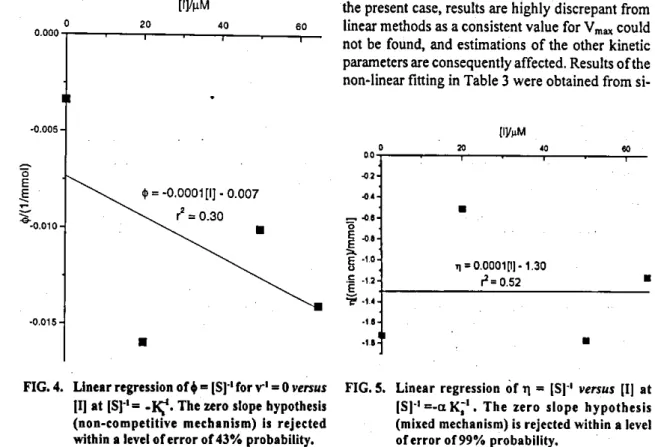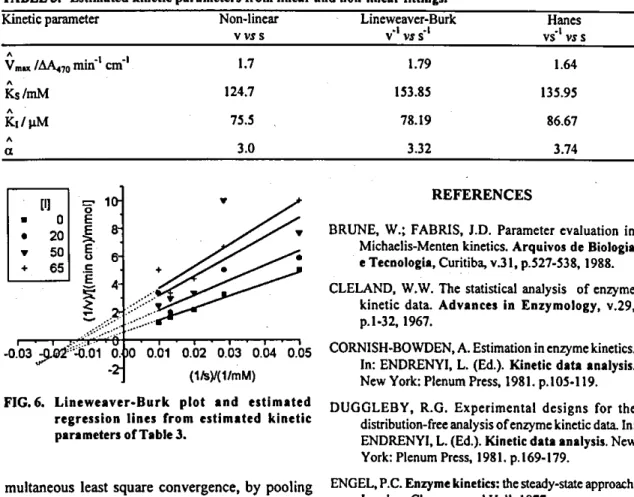KINETIC ANALYSIS OF INHIBITOR ACTIONS ON ENZYMES 1
WALTER BRUNE2, JOSÉ DOMINGOS FABRIS3, ANTÔNIO CARLOS DE OLIVEIRA4,
TANtA TOLEDO OLIVEIRA5 and TANUS JORGE NAGEM5
ABSTRACT - A set of data on a given peroxidase inhibition by quecertin, showing an unusually high experimental error, was used to demonstrate how data, seemingly unsuitable for graphical analysis, may still provide useful information on the inhibition mechanism. The most reliable model turned out to be a mixed non-competitive inhibition. The present statistical procedure has proved (i) to be a simple, general and unequivocal way to carry on kinetic analysis of enzymatic reactions under inhibi-tion acinhibi-tion, based only on consecutive linear regressions (no previous assunipinhibi-tion about the inhibiinhibi-tion mechanism is required); (ii) that experimental errors can play an essential role on the final decision about the inhibition mechanism and (iii) to be able to show how dose to the Michaetis-Menten mecha-nism the kinetic model actually is. Therefore ali proposed inhibition mechamecha-nisms were subjected to statistical judgement.
index terms: Michaelis-Menten, kinetics, inhibition.
ANÁLISE CINÉTICA DAS AÇÕES DOS INIBIDORES SOBRE AS ENZIMAS RESUMO - Um conjunto de dados, com alta dispersão experimental, de uma reação de inibição de uma peroxidase por quecertina foi usado para demonstrar o modo pelo qual é possível, através de manipulação gráfica e de análise de regressão linear, obter resultados estatisticamente interpretáveis sobre o mecanismo da inibição enzimática. O modelo cinético mais provável da reação foi estabeleci-do como senestabeleci-do ode uma inibição não-competitiva mista. O procedimento estatístico aqui proposto (i) revelou-se relativamente simples, geral e método não-amblgüo de análise numérica em cinética enzimática envolvendo inibição, baseado em regressões lineares consecutivas, e que não requer, ne-cessariamente, o estabelecimento prévio de uma hipótese do tipo de inibição; (ii) pôs em evidência a influência dos erros experimentais na decisão sobre o mecanismo da reação de inibição e (iii) permitiu verificar a validade do modelo cinético e em qual extensão é explicado pela equação de Michaelis--Menten. Por isso, todos os métodos de inibição propostos foram submetidos ajulgamento estatístico. Termos para indexação: Michaelis-Menten, cinética, inibição.
INTRODUCTION
Experimentally, kinetic studies on enzyme reac-tions that foliow Michaelis-Menten (MM) formal-ism require quite a few prerequisites, such as: (1) enzyme integrity during experiments, (ii) a much
Accepted for publication on November 7, 1996.
1 Eng. Agr., 1k., Dep. de Zootecnia, Universidade Federal de
Viçosa (UFV), CEP 36570-000 Viçosa, MC, Brazil.
3 Eng. Agr., Dt, Embrapa - Centro Nacional de Pesquisa de
Milho e Sorgo (CNPMS), Caixa postal 151, CEP 35701-970 Sete Lagoas, MC, Brazil.
'Eng. Agr.. Dr. • Embrapa - CNPMS. Qui mica, Dra. , Dep. de Química, UFV.
'Farmacbjtico Bioqulmico, 1k., Dep. de Química, Univesidade Federal de Ouro Preto, CEP 35400-000 Ouro Preto, MC, Brazil.
higher equilibrium formatiort rate between enzyme and substrate than that of product fonnation, (iii) well defined stoichiometry, (iv) onIy one substrate moleeule to be bound to lhe activity center ata time, and (v) fuil reversibihty of enzyme-ligand associa-tion (Keleti, 1986); also (vi) any ligand excess ef-fects should be avoided. Moreover, it seems also suitable lo measure activities iii lhe steady-state. Previous tests should be carried out to estabiish an optirnal range of inhibitor and substrate concentra-tions (Brune & Fabris, 1988).
These restrictions, though of relatively easy ex-perimental control, make lhe kinetic parameter de-terminations somewhat artificial (Hill et ai., 1977). Decisions within established reaction mechanisms are usually a malter of intuition, statistical standard
458 W. BRUNE et ai.
deviation analysis and biases (Keleti, 1983). On the other hand, the knowledge of kinetic parameters ai-lows comparisons and standardization of enzyme reactions and also speculations about their molecu-lar mechanisms.
A widely applied technique for parameter evalu-ations througb plotting reaction rate versus substrate concentration is the Lineweaver-Burk (LB) graph, which helps distinguish neatly among altematives of the substrate-inhibitor-enzyme binding nature (Engel, 1977), though other linearization methods are also used for this purpose (Cleland, 1967; Metzler, 1977). Since there are unavoidable enors to be taken into account, the observed results may become graphically blurred (Comish-Bowden, 1981; Duggleby, 1981; Prats & Rodriguez, 1992). Even• tually it tums out to bejust a matter ofpersonaljudge-ment whether or not a putative reaction model is likely to occur (Mannervik; 1981, 1982).
Even though academic or commercial fitting computer routines based on non-linear algorithms are available for many general statistical purposes, kinetic parameters of enzyme reactions following MM kinetics are more commonly estimated through well-known linear numerical techniques, e.g., that ofLB plots. Even in the presence of a second ligand, the kinetic parameters may be evaluated numerically by linear statistical methods. This is also valid for equilibrium constants ofreactions involving a modi-fied enzyme molecule.
The initial enzymatic reaction
E + S± ES
has an equilibrium constant given by
[EI(S) [ESI'
where E, 5 and ES represent, respectively, the unengaged enzyme, substrate and enzyme-substrate complex; whiie brackets stand for thëir related concentrations.
lfthe enzyme is previousiy coupied to an inhibi-tor, 1, the new equilibrium constant is
* [EU(S)
K - 5
- IESI]
Similarly, the equilibrium
Pesq, agropec. bras., Brasilia, v.32, n.5, p.457-464, maio 1997
E + 1 t EI
has an equilibriuxn constam given by
[El]
and, by analogy,
KI = [ESJII] [ESI]
So far, the scientific literature has not clearly ex-plained how to ascertain best estimated values of kinetic parameters and their related statistical errors in a broad sense, disregarding the previous knowl-edge of any assumed inhibition action (Krantz,
1992). Particular cases, like simultaneous linear fit-ting of a family of straight lines disclosing a singie point convergence or focus (Junqueira & Mares--Guia, 1990) are well established. However, cur-rently used methods are more commonly based on individual Iineú analysis. We hereupon propose an improved statisticai procedure based 011 secondary
linear piots following lhe primary LB representa-tion, which estimates kinetic parameters and their related variances for any enzyme reaction, indepen-dently of its molecular inhibition mechanism.
The general kinetic model ofan overail inhibited enzyme reaction is given by (Keleti, 1986):
K E1K
E
ESI
ESÁI
E+P
where 1' is the product. Formaiiy,
VA = (1 + a[l]K')V ± (1 + (l]lÇ') Kv;L[Sf', (1)
where cx = K1K' ; v and Vmax have their
KINETIC ANALYSIS OF INHIBITOR ACT1ONS ON ENZYMES 459
In short, this eqn. (1) may be represented by of enzyme inhibited reactions, which would permit
v -1 z+w[S] -1 the estimation of more reliable kinetic parameters.
where
w=(1+[1]Kj5K5V, (2)
and
z=(l+a[l]K')V,L. (3)
A primary LB plot, vir V versus [S]-' , leads to a linear fitting for every individual [1].
For a family ofi straight lines each correspond-ing to a specific concentration ofthe inhibitor, [1], linear regressions may allow the estimation ofsets ofi slopes (w) and i intercepts (z), as deduced from eqn.(1).
Taking into account secondary plots relating z's and w's versus [I]'s, the slopes ('41w and
'vi.
• (4)
and
(5)
and intercepts
(L
and(6)
and
(7)
may be estimated.
The equations (4) through (7) lead to the param-eter evaluations of eqn (1). The sequential linear regressions give risc to two kinds of statistical er-rors affecting the parameter values: (i) the standard deviation dueto experimental dispersion and (ii) the systematic errors propagated through presumed es-timation steps.
Data from a peroxidase reaction inhibited by quer-cetin is used to demonstrate the procedure.
The main purpose of this work is lo establish a statistically-based criterion to select at least one out of a collection of possible molecular mechanisms
MATERIAL AND METHODS
Enzymc reaction
Peroxidase (EC 1.11.1.7) catalyzes the reaction ofguai-acol with 11202 and its inhibition was studied by adding lo the reaction medium a flavone, quercetin, exliacted from lhe radish. The reaction was followed spectrometrically through its absorption at 470 rim in 1 cm light path cells. The assay medium contained also tris(hydroxymethyl) aminomethane(Tris)/HCI, p11 7.2,10 mM, CaCl20.5 mM and 112020.3 mM, and increasing amounts of guaiacol (10.0. 13.3, 20.0, 28.6 and 50.0 mM) and queráetin (0, 20, 50 and 65 isM). The reaction was started by lhe additon of 50 14L of a peroxidase (Merck) solution con-taining 10 mg of enzyme in 150 mL of Tris/HCI p11 7.2. The final assay volume was 3.0 mL and absorption read-ings were followed during 5 mm, when lhe reaction rate was visibly siowing down. The temperature of the reac-lion cells was maintened belween 22 and 23°C (Oliveira,
1994).
Estimation of absolute kinetic parameters
Firstly, V1 values, expressed as a dependent variable,
are plotted as a funclion of [S] -' for every [1]. The LB plots are presented inFig. 1 and Iinearparameters are pre-sented iii Table 1. The family ofi lines may converge to a focus Iocated, within the experimental errors, (1) on the abscissa axis (simple non-competitive inhibition, a 1); (ii) on lhe ordinate (competitive, a = 0); (iii) on the sec-ond quadrant (mixed non-competitive, a < 1); (iv) in the lhird quadrant (mixed non-competitive, a> 1) or (v) may not converge aI ali (parallel lines; uncompelitive) (Engel, 1977), where lhe enzyme afflnity toward lhe second ligand has somehow been changed, as lhe result of a previous engagemenl (ES or El). The crilerion to selecl one ofthe above alternatives requires a hypothesis tesl that is de-scribed in lhe next steps.
Secondly, lhe slopes w [eqn. (2)] of each straight line i are plotted against [1], to give a new linear pattern (Fig. 2). The least square fitting of these new data allows an estimation of lhe slope, 4tw [eqn. (4)] and lhe intercept,
[eqn. (6)1.
Thirdly, lhe intercepts zj [eqn. (2)] are plotted against [1] and the new (Fig. 3) siope 41 z [eqn. (5)] and intercept [eqn. (7)] may now be estimated. AlI individual param-eters are algebraically related and completely define eqn. (1).
460 W.BRUNE etal.
11 10 9 8-
-e
o
E '
E
o
a
4. .3. 2
1 .
0.01 • 0.02 • 0.03 0.04 0.05
• •
(1/s)1[1/mM]
• FIG. 1. Lineweaver-Burk representation of linear fittings, relating v' venta r'. Estimated regressions parameters are presented in Table 1. Inset: schematic graphical • representation of used symbols.
TABLE 1. Linear parameters estimated from the
-: Lineweaver-Burk Piot, according to eqn. (1).
[1] Slope (w) Intercept (z) r2
0 94.92 0.32 0.99
20 90.74 1.45 0.83
50 153.43 1.54 0.73
65 152.99 2.14 0.94
Finally, four hypotheses are hereby tested, using the t-distribution as a statisticat criterion (Table 2): (i) ifthe set of siopes of the linear regressions relating w's, from eqn. (2), versus [1] is statisticalty zero (Fig. 2), the straight tines in the primar)' plot (Fig. 1) may be assumed as being parallel (uncompetitive inhibition); (ii) if the set ofslopes
from the linear regression relating the interceptsz's, from eqn. (3), versus [1] [eqn. (5)] is statistically zero (Fig. 3), the focus may be located on the ordinate (competitive in-hibition); a set of$'s at IS' =.lÇ 1 are calcutated from eqn. (1), by making v = 0; (iii) if the sldpe of the linear regression retating
4
versus [1] is statisticatly zero (Fig. 4), there is a focus located on the abscissaa
.IÇ' (a = 1, non-competitive); and (iv) if the previous three hypotheses are rejected, a being neither'one nor zero, the inhibition may be mixed (partially competitive), provided that the straight tines in the primary ptot converge to a point on the second or third quadrant having an ancitlary coordinate at [S1 -a K'. Values ofv (namely,4's)
at this abscissa point are ptotted against [1] (Fig. 5), and the statisticat test for zero siope value indicates whether or not the mixed inhibition model may be accepted.
o E
c E
l
y
o E
E c E El
KINETIC ANALYSIS OF INHIBITOR ACTIONS ON ENZYMES 461
(IVMM (1J4tM
FIG. 2. Linear regression ofsiopes (w) estimated (tom FUI 3. Linear regression o( intercepts (z) estimated fittings shown lo Fig. 1 and Table 1 venais (rom flttings shown lo Fig. 1 and Table 1 inhibitor concentrations, 111. The zero siope venus inhibitor concentrations, (lj. The zero hypothesls (uncompetitive mechanism) is siope hypothesis (competitive mechanism) is rejected within a levei of error o( 5% rejected within a levei or error or 5%
probabiiity. probability.
TABLE 2. Hypothesis-tests concerning the inhibition mechanism by using t-distribution.
Inhibition mechanism Slope r' t Probability Decision
Uncompetitive 1.099 0.85 3.35 0.05 Rejected
Competitive 0.024 0.85 3.26 0.05 Rejected
Non-competitive 0.000 0.30 0.92 0.43 Not rejected
Mixed 0.000 0.01 0.01 0.99 Notrejected
RESULTS AND DISCUSSION
It was not possible to unambiguously discem any trend for a non-MM kinetics, by inspecting Fig. 1 on!y. Iii addition, the trends expressed ia Figs. 2, 3 and 4 suggest non-validity of competitive, uncompetitive and non-competitive inhibitions. This interpretation is corroborated by the individual tra-jectories on the third quadrant, as shown in Fig. S.
The poiais are evenly scattered around the horizon-
tal une representing the linear regression. Further-more, li gives no clue for a non-linear fitting (Orsi & Tipton, 1979; Johnson & Frasier, 1985). On the basis ofthese arguments, it is plausible to consider the hypothesis that the kinetic mechanism foliows the partial or the mixed inhibition model (Keleti, 1986). According to the t-distribution analysis (Table 2)the uncompetitive and competitive inhibi-tions are statistically rejected within <0.05 probabil-ity. The other two mechanisms, non-competitive and
462 W. BRUNE ei ai.
mixed, are rejected with a much higher error levei,
vii 0.43 and 0.99, respectiveiy. This means that one
ofthem couid be accepted, but fiirther experimental and statistical refmements wouid be required. The highly scattered experimental data, as shown by the primary LB piot (Fig. 1) is the main cause of such a lack of discrimination. The experimental error weighting and higher number of measured points in the primary linear regression woutd be a way to improve statistical confidence, but independent bio-chemical information wouid be uitimately necessary for a consistent decision. Because partial inhibition exhibits a focus on aplane, not on a coordinate axis, te focus location reflects the change in enzyme af-finity to one ligand by a former association with another one. Similar observations in ali branches of chemistry sustain this seemingiy general phenom-enon. For instance, the flrst reaction of an organic acid with an aicohol virtually always interferes with further sequential steps of te esterification. In te case ofthe enzyme reaction, a focus on te ordinate
[l]4tM
O 20 40 60
o E
or on te abscissa, as well as a piot of siopes in re-sponse to a second ligand is confined to particular cases and to those where a statisticaiiy tenabie deci. sion cannot be made.
It is interesting to compare estimations of kinetic parameters obtained from te present LB (v vs sA)
linearization with those from other techniques, namely Hanes (sr1 vs s), and direct non-linear
fit-ting using Michaeiis-Menten (v vs s) model. Results
are presented in Tabie 3. Fig. 6 represents LB plots based on te set ofkinetic parameters estimated ac-cording to te present procedure. Uniike the primary LB plots in Fig. 1, te straight lines in Fig. 6 con-verge to acommon point, as expected from te mixed non-competitive inhibition model. The Eadie--Hofstee (vs vs v) procedure gave inconsistent
te-sults and is not presented. Notice that in the Hanes & Eadie-Hofstee linearization strategies, lhe two variabies, v and s, are not completely separated, as required for linear fitting. On te oter hand, non-linear fittings are strongly influenced by experimen-tal data in te asymptotic region of te v-s curve. In the present case, results are highly discrepani from linear metods as a consistem value for V,. could not be found, and estimations of te oter kinetic parameters are consequently affected. Results ofthe non-linear fitting in Table 3 were obtained from si-
liygm
20
o
E E
1
FIG. 4. Linear regression of 4 = 1S1 1 for v4 = O versus
jIl at ISF'= _IÇ'. The zero siope hypothesis (non-competitive mechanism) is rejected within a levei of error of 43% probabiiity.
FIG. S. Linear regression of r 1SF' versus [1] at -a Ç'. The zero siope hypothesis (mixed mechanism) is rejected within a levei oferror of99% probability.
KINETIC ANALYSIS OF INHIBITOR ACTI0NS ON ENZYMES 463
TABLE 3. Estimated kinetic parametcrs from linear and non-linear fittings.
Kinetic parameter Non-lincar Lineweavcr-Burk Hanes
035 V1VSS VS1VSS
1AA470 min4 cm4 1.7 1.79 1.64
ÇCsImM 124.7 153.83 135.95
KzIiiM 75.5 78.19 86.67
a 3.0 3.32 3.74
n
E.E E
-0.03
(lls)/(lImM)
FIG. 6. Lineweaver-Burk piot and estimated regression unta from estimated kinetic parameters of Table 3.
multaneous Ieast square convergence, by pooling sets of v-s data from ali four inhibition concentra-tions into one input set. A Fortran prograxn was writ-ten based on the iterative Marquardt (1959, 1963) algorithm, to perform least square minimization.
CONCLUSIONS
1. The present statistical procedure is a simple, general and clear way to carry out kinetic analysis ofenzymatic reactions under inhibition action, based oniy on consecutive linear regressions.
2. It puts in evidence that the experimental errors can play an essential role on the final decision about the inhibition mechanism.
3. li enables one to show how dose to the Mjchae-lis-Menten mechanism the kinetic model actually is, as ali proposed inhibition mechanisms can theoreti. cally be rejected.
REFERENCES
BRUNE, W.; FABRIS, J.D. Parameter evaluation iii Michaelis-Menten kinetics. Arquivos de Biologia e Tecnologia, Curitiba, v.31, p.527-538, 1988.
CLELAND, W.W. The statistical analysis of enzyme kinetic data. Advances la Enzymology, v.29, p.I-32, 1967.
CORNISH-BOWDEN, A. Estimation in enzyme kinetics. In: ENDRENYI, L. (Ed.). Kinetic data analysis. New York: Pienum Press, 1981. p.I05-I 19.
DUGGLEBY, R.G. Experimental dcsigns for the distribution-free analysis of enzymc kinetic data. In: ENDRENYI, L. (Ed.). Kinetic data analysis. New York: Pienum Press. 1981. p.I69-179.
ENGEL, P.C. Enzyme kinetics: the steady-state approach. London: Chapman and Hall, 1977.
HILL, C.M.; WAIGHT, R.D.; BARDSLEY, W.G. Does any enzyme foilow lhe Michaelis-Menten equation? Molecular Ccli Biocbemistry, v.15, p.173I78, 1977.
JO1-INSON, M.L.; FRASIER, S.G. Nonlinear
leasl--squares analysis. Methods in Enzymology, vil?, p.301-342. 1985.
JUNQUEIRA, R.G.; MARES-GUIA, M. A statistical treatment for solution of a family ofsimultaneous equations derived from cnzyme inhibition studies. Brazilian Journai of Medical and Biological
Research, v.23, p.773-784, 1990.
KELETI, T. Basic enzyrnc kinctics. Budapest: Académiai Kiadó, 1986. 421p.
KELETI. T. Errors in the evaluation of Anhenius and van't l-lofl'plots. Biochemical Journal, v.209, p.277-280,
1983.
464 W. BRUNE et ai.
KRANTZ, A.A. Ciassification of enzyme inhibitors. MARQUARDT. D.W. Solution of noniinear chemicai Bioorganic Medicinal Cbemistry Letters, v.2, engineering modeis. Chemical Engineering
p.1327-1334, 1992. Progress, v.55, p.65-70, 1959.
MANNERVIK, B. Design and anaiysis of kinetic experiments for discrimination between rival modeis. in: ENDRENYI, L. (Ed.). Kinetic data analysis. New York: Pienum Press, 1981. p.235-270. MANNERVIK, B. Regression analysis, experimental
aTor, and statistical criteria in lhe design and analysis of experiments for discrimination between rival kinetic modeis. Methods in Enzymology, v.87, p.370-390, 1982.
MARQUARDT, D.W. An aigorithm for ieast-squares estimation of nonlinear parameters. .Journal ofthe Society for Industrial and Applied Mathematics,• v.1l,p.431-44l, 1963.
METZLER, D.E. Biochemistry: lhe chemical reactions ofiiving celis. New York: Academic Press, 1977. OLIVEIRA, T.T. de. Estudo químico e bioquímico de
diversas variedades de soja, Glycine max,
Leguminosse. Belo Horizonte: UFMG, 1994. Tese de Doutorado.
ORSI, B.A.; TIPTON, K.F. Kinetic analysis ofprogress curves. Methods ia Enzymology, v.63, p.159-1 83,
1979.
PRATS, M.; RODRIGUEZ, F. A Michaeiis-Menten enzyme: time correction introduced for computing kinetic parameters at Iow vaiues of [S]IK_. Biochemicai Education, v.20, p.176-177, 1992.



